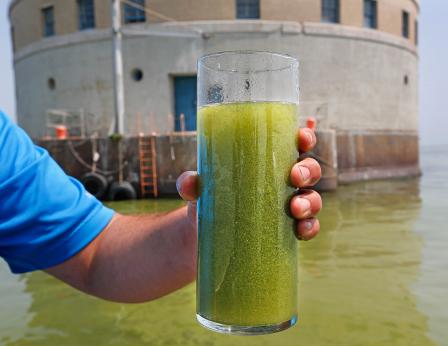Harmful Algal Blooms & Drinking Water Treatment
 Toxins from harmful algal blooms (HABs) are increasingly contaminating sources waters, as well as the drinking water treatment facilities that the source waters supply. These treatment facilities face a difficult task of not only removing the toxins, but doing so in a safe and cost-effective way. EPA's research is helping communities confront this challenge.
Toxins from harmful algal blooms (HABs) are increasingly contaminating sources waters, as well as the drinking water treatment facilities that the source waters supply. These treatment facilities face a difficult task of not only removing the toxins, but doing so in a safe and cost-effective way. EPA's research is helping communities confront this challenge.
Harmful Algae, Nutrients, and Land Use
The golden alga (Prymnesium parvum) has been introduced to multiple regions in the United States. EPA researchers are exploring the interacting environmental factors that contribute to golden alga invasions and are examining the specific risks posed by these blooms in drinking water sources. Examination of the land use factors driving invasions and the spread are being conducted with the aim of guiding sustainable management of drinking water resources; these issues are also being explored in the context of future scenarios of global climate change.
Lake Erie Research
Lake Erie is a drinking water source for numerous communities. Cyanobacterial harmful algal blooms (CyanoHABs) have been increasing in severity and toxin production on the lake over the past five years. In September of 2013, the Ohio Environmental Protection Agency (Ohio EPA) placed a community under a "Do Not Drink” advisory due to the breakthrough of toxins into the finished public drinking water. Many of the treatment facilities on the lake were built before World War II and were designed for particulate removal. As a result, toxin removal at these facilities is difficult and expensive. Recognizing the potential health and economic consequences, EPA researchers, in partnership with Ohio EPA and the U.S. Geological Survey, are conducting studies aimed at helping treatment facilities cope with this water quality change in their surface water source and finished waters.
- Spread of Cyanobacteria and Their Toxins: In May 2013, EPA started collecting monthly samples from seven drinking water treatment facilities distributed along the entire Ohio shoreline of Lake Erie. The samples were collected from six to nine locations (through the treatment trains) at each facility, and sampling continued for several years between the months of May through December. The samples locations were from raw water, finished water, and selected, site-specific intermediate locations. The raw water qualities at the facilities range from mildly to highly bloom-impacted. All samples are being analyzed for cyanobacteria, their toxins, chlorophyll-a, and other chemical and microbiological markers commonly associated with CyanoHABs.
This study represented a unique opportunity to characterize the development of Lake Erie’s CyanoHABs and their associated toxins at a high level of analytical detail. Because different classes of toxins, and even variants within the classes, exhibit differing degrees of treatability, tracking their possible spread or removal through a treatment facility will be extremely beneficial. The knowledge gained will allow utilities and regulators to make better-informed long-term decisions regarding the operation and modification of treatment processes to optimize toxin removal.
- Removal of Cyanobacterial Toxins: EPA researchers are looking for ways to improve the performance of existing operations by modifying the locations where treatment chemicals are applied, the types and concentrations of chemicals applied, and the pH at which the processes are operated. The more modern systems research is focused on the impacts of pH and hydrogen-peroxide addition on ozone contactor efficiency. All results are shared with the state
Measuring Microcystin Concentrations in Water
HABs are a major concern for recreational activities as well as drinking water treatment facilities. One type of toxin produced by cyanobacteria are known as microcystins. Fish, birds and mammals can ingest these toxins. People swimming, waterskiing, or boating in contaminated water can also be exposed to microcystins. Pets and livestock have died from drinking water contaminated with microcystins. Enormous blooms of cyanobacteria have the potential to produce harmful algal toxins that include several variants of microcystins. Each microcystin variant differs in both occurrence and toxicity. This research looks at ways to correctly analyze and measure microcystins to monitor and regulate the toxins while assessing exposure for both recreational and drinking water purposes.
Related Water-Quality Trading Research
The drinking water treatment plant operation has received critical focus in a study examining the barriers to water-quality trading in mixed use watersheds. The research is focused on determining if there are cost incentives for drinking water treatment facilities to become participants in water quality trading. Since harmful algal blooms have become a significant driver of treatment costs there is a need to be able to link algal bloom dynamics directly to watershed-level sediment and nutrient controls. This research will also consider recreational water decision-makers.
